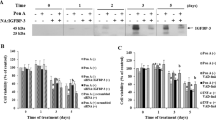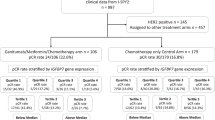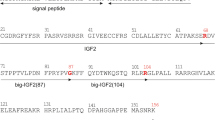Abstract
The relationship between oestrogen (E2) and insulin-like growth factor-one (IGF-1) was examined in both tamoxifen-sensitive (MCF 7/5–21) and tamoxifen-resistant (MCF 7/5–23) subclones of the MCF 7 cell line. Both subclones were grown in defined, serum-free (SF) medium over a period of 7 days with the addition of E2or IGF-1 or a combination of both agents. Growth of both MCF 7/5–21 and 7/5–23 cells was stimulated (245% and 350%, respectively) by E2. However, only the growth of MCF 7/5–23 cells was stimulated (266%) by IGF-1. A combination of E2and IGF-1 significantly enhanced MCF 7/5–21 and 7/5–23 cell growth (581% and 695%, respectively). E2-induced IGF-1 receptor (IGF-1R) levels (as measured by 125I-IGF-1 binding and Northern analyses) in only MCF 7/5–23 cells. This effect was partially inhibited by tamoxifen. In medium containing serum, the growth of only the MCF 7/5–23 cells was significantly inhibited by the IGF-1R monoclonal antibody, αIR-3. The detection of E2-induced expression of IGF-2 using RT-PCR was demonstrated in the MCF 7/5–23 cells. These experiments indicate that E2may sensitize tamoxifen-resistant MCF 7/5–23 cells to the growth stimulatory actions of IGF-2 via up-regulation of the IGF-1R and describes a cell-survival mechanism that may manifest itself as tamoxifen resistance.
Similar content being viewed by others
Article PDF
Change history
16 November 2011
This paper was modified 12 months after initial publication to switch to Creative Commons licence terms, as noted at publication
References
Arteaga, C. L. & Osborne, C. K. (1989). Growth inhibition of human breast cancer cells in vitro with an antibody against the type I somatomedin receptor. Cancer Res, 49, 6237–6241.
Baserga, R., Hongo, A., Rubini, M., Prisco, M. & Valentinis, B. (1997). The IGF-1 receptor in cell growth, transformation and apoptosis. Biochim Biophys Acta, 1332, F105–F126.
Berthois, Y., Katzenellenbogen, J. & Katzenellenbogen, B. (1986). Phenol red in tissue culture media is a weak estrogen: implications concerning the study of estrogen-responsive cells in culture. Proc Natl Acad Sci USA, 83, 2496–2500.
Chomczynski, P. & Sacchi, N. (1987). Single-step method of RNA isolation by acid guanidinium thiocyanate-phenol-chloroform extraction. Anal Biochem, 162, 156–159.
Clarke, R., Howell, A. & Anderson, E. (1997). Type I insulin-like growth factor receptor gene expression in normal human breast tissue treated with oestrogen and progesterone. Br J Cancer, 75, 251–257.
Darbre, P., Yates, J., Curtis, S. & King, R. (1983). Effect of estradiol on human breast cancer cells in culture. Cancer Res, 43, 349–354.
Decupis, A., Noonan, D., Pirani, P., Ferrera, A., Clerico, L. & Favoni, R. E. (1995). Comparison between novel steroid-like and conventional nonsteroidal antioestrogens in inhibiting oestradiol- and IGF-1-induced proliferation of human breast cancer-derived cells. Br J Pharmacol, 116, 2391–2400.
Dickson, R. B., Johnson, M. D., el Ashry, D., Shi, Y. E., Bano, M., Zugmaier, G., Ziff, B., Lippman, M. E. & Chrysogelos, S. (1993). Breast cancer: influence of endocrine hormones, growth factors and genetic alterations. Adv Exp Med Biol, 330, 119–141.
Dunn, S., Hardman, R., Kari, F. & Barrett, J. (1997). Insulin-like growth factor 1 (IGF-1) alters drug sensitivity of HBL100 human breast cancer cells by inhibition of apoptosis induced by diverse anticancer drugs. Cancer Res, 57, 2687–2693.
Encarnacion, C. A. & Fuqua, S. A. (1994). Oestrogen receptor variants in breast cancer. Cancer Treat Res, 71, 97–109.
Freiss, G., Rochefort, H. & Vignon, F. (1990). Mechanisms of 4-hydroxytamoxifen anti-growth factor activity in breast cancer cells: alterations of growth factor receptor binding sites and tyrosine kinase activity. Biochem Biophys Res Commun, 173, 919–926.
Hu, X. F., Veroni, M., De Luise, M., Wakeling, A., Sutherland, R., Watts, C. K. & Zalcberg, J. R. (1993). Circumvention of tamoxifen resistance by the pure antioestrogen ICI 182,780. Int J Cancer, 55, 873–876.
Huff, K., Kaufman, D., Gabbay, K. H., Spencer, E. M., Lippman, M. E. & Dickson, R. B. (1986). Secretion of an insulin-like growth factor-I-related protein by human breast cancer cells. Cancer Res, 46, 4613–4619.
Huynh, H., Nickerson, T., Pollak, M. & Yang, X. F. (1996). Regulation of insulin-like growth factor I receptor expression by the pure antioestrogen ICI 182,780. Clin Cancer Res, 2, 2037–2042.
Jones, J. I. & Clemmons, D. R. (1995). Insulin-like growth factors and their binding proteins: biological actions. Endocr Rev, 16, 3–34.
Karey, K. & Sirbasku, D. (1988). Differential responsiveness of human breast cancer cell lines MCF-7 and T47D to growth factors and 17 beta-estradiol. Cancer Res, 48, 4083–4092.
Kato, S., Endoh, H., Masuhiro, Y., Kitamoto, T., Uchiyama, S., Sasaki, H., Masushige, S., Gotoh, Y., Nishida, E., Kawashima, H., Metzger, D. & Chambon, P. (1995). Activation of the oestrogen receptor through phosphorylation by mitogen-activated protein kinase. Science, 270, 1491–1494.
Katzenellenbogen, B. S. & Norman, M. J. (1990). Multihormonal regulation of the progesterone receptor in MCF-7 human breast cancer cells: interrelationships among insulin/insulin-like growth factor-I, serum, and oestrogen (published erratum appears in Endocrinology 1990; 126: 3217). Endocrinology, 126, 891–898.
Kleinman, D., Karas, M., Roberts, C. J., LeRoith, D., Phillip, M., Segev, Y., Levy, J. & Sharoni, Y. (1995). Modulation of insulin-like growth factor I (IGF-1) receptors and membrane-associated IGF-binding proteins in endometrial cancer cells by estradiol. Endocrinology, 136, 2531–2537.
Kull-Jr, F. C., Jacobs, S., Su, Y., Svoboda, M., Van Wyk, J. & Cuatrecasas, P. (1983). Monoclonal antibodies to receptors for insulin and somatomedin-C. J Biol Chem, 258, 6561–6566.
Lee, A. V. & Yee, D. (1995). Insulin-like growth factors and breast cancer. Biomed Pharmacother, 49, 415–421.
Lee, A. V., Darbre, P. & King, R. (1994a). Processing of insulin-like growth factor-II (IGF-II) by human breast cancer cells. Mol Cell Endocrinol, 99, 211–220.
Lee, A. V., Toi, M. & Yee, D. (1994b). Tamoxifen resistant MCF 7 cells exhibit increased expression of insulin-like growth factor-II (IGF-II). Breast Cancer Res Treat, 32S, 57
Lippman, M. E. (1985). Growth regulation of human breast cancer. Clin Res, 47, 375–382.
McCotter, D., Vandenberg, H. W., Boylan, M. & McKibben, B. (1996). Changes in insulin-like growth factor-I receptor expression and binding protein secretion associated with tamoxifen resistance and oestrogen independence in human breast cancer cells in vitro. Cancer Lett, 99, 239–245.
Musgrove, E. A. & Sutherland, R. L. (1993). Acute effects of growth factors on T47D breast cancer cell cycle progression. Eur J Cancer, 29A, 2273–2279.
Newton, C. J., Trapp, T., Pagotto, U., Renner, U., Buric, R. & Stalla, G. K. (1994). The oestrogen receptor modulates growth of pituitary tumour cells in the absence of exogenous oestrogen. J Mol Endocrinol, 12, 303–312.
Osborne, C., Coronado, E. B., Kitten, L. J., Arteaga, C. L., Fuqua, S. A., Ramasharma, K., Marshall, M. & Li, C. H. (1989). Insulin-like growth factor-II (IGF-II): a potential autocrine/paracrine growth factor for human breast cancer acting via the IGF-1 receptor. Mol Endocrinol, 3, 1701–1709.
Papa, V., Gliozzo, B., Clark, G. M., McGuire, W. L., Moore, D., Fujitayamaguchi, Y., Vigneri, R., Goldfine, I. D. & Pezzino, V. (1993). Insulin-like growth factor-I receptors are overexpressed and predict a low risk in human breast cancer. Cancer Res, 53, 3736–3740.
Parisot, J. P., Hu, X. F., Sutherland, R., Wakeling, A., Zalcberg, J. & DeLuise, M. (1995). The pure antioestrogen ICI 182,780 binds to a high-affinity site distinct from the oestrogen receptor. Int J Cancer, 62, 480–484.
Pekonen, F., Partanen, S., Makinen, T. & Rutanen, E. (1988). Receptors for epidermal growth factor and insulin-like growth factor I and their relation to steroid receptors in human breast cancer. Cancer Res, 48, 1343–1347.
Peyrat, J., Bonneterre, J., Hecquet, B., Vennin, P., Louchez, M., Fournier, C., Lefebvre, J. & Demaille, A. (1993). Plasma insulin-like growth factor-1 (IGF-1) concentrations in human breast cancer. Eur J Cancer, 29A, 492–497.
Quinn, K. A., Treston, A. M., Unsworth, E. J., Miller, M. J., Vos, M., Grimley, C., Battey, J., Mulshine, J. L. & Cuttitta, F. (1996). Insulin-like growth factor expression in human cancer cell lines. J Biol Chem, 271, 11477–11483.
Reddel, R. R., Alexander, I. E., Masfumi, K., Shine, J. & Sutherland, R. (1988). Genetic instability and the development of steroid hormone insensitivity in cultured T47D human breast cancer cells. Cancer Res, 48, 4340–4347.
Resnicoff, M., Abraham, D., Yutanawiboonchai, W., Rotman, H. L., Kajstura, J., Rubin, R., Zoltick, P. & Baserga, R. (1995). The insulin-like growth factor I receptor protects tumor cells from apoptosis in vivo. Cancer Res, 55, 2463–2469.
Rohlik, Q., Adams, D., Kull, F. C. Jr & Jacobs, S. (1987). An antibody to the receptor for insulin-like growth factor I inhibits the growth of MCF-7 cells in tissue culture. Biochem Biophys Res Commun, 149, 276–281.
Steele-Perkins, G., Turner, J., Edman, J. C., Hari, J., Pierce, S. B., Stover, C., Rutter, W. J. & Roth, R. A. (1988). Expression and characterization of a functional human insulin-like growth factor I receptor. J Biol Chem, 263, 11486–11492.
Stewart, A. J., Johnson, M. D., May, F. E. & Westley, B. (1990). Role of insulin-like growth factors and the type I insulin-like growth factor receptor in the oestrogen-stimulated proliferation of human breast cancer cells. J Biol Chem, 265, 21172–21178.
Stewart, A. J., Westley, B. & May, F. (1992). Modulation of the proliferative response of breast cancer cells to growth factors by oestrogen. Br J Cancer, 66, 640–648.
Thorsen, T., Lahooti, H., Rasmussen, M. & Aakvaag, A. (1992). Oestradiol treatment increases the sensitivity of MCF-7 cells for the growth stimulatory effect of IGF-1. J Steroid Biochem Mol Biol, 41, 537–540.
Toi, M., Harris, A. & Bicknell, R. (1993). cDNA transfection followed by the isolation of a MCF-7 breast cell line resistant to tamoxifen in vitro and in vivo. Br J Cancer, 68, 1088–1096.
Ullrich, A., Gray, A., Tam, A., Yang-Feng, T., Tsubokawa, M., Collins, C., Henzel, W., Le Bon, T., Kathuria, S., Chen, E., et al (1986). Insulin-like growth factor I receptor primary structure: comparison with insulin receptor suggests structural determinants that define functional specificity. EMBO J, 5, 2503–2512.
van den Berg, H. W., Claffie, D., Boylan, M., McKillen, J., Lynch, M. & McKibben, B. (1996). Expression of receptors for epidermal growth factor and insulin-like growth factor I by ZR-75-1 human breast cancer cell variants is inversely related – the effect of steroid hormones on insulin-like growth factor I receptor expression. Br J Cancer, 73, 477–481.
Werner, H., Woloschak, M., Adamo, M., Shen-Orr, Z., Roberts, C. T. Jr & LeRoith, D. (1989). Developmental regulation of the rat insulin-like growth factor I receptor gene. Proc Natl Acad Sci USA, 86, 7451–7455.
Westley, B. R. & May, F. (1994). Role of insulin-like growth factors in steroid modulated proliferation (Review). J Steroid Biochem Mol Biol, 51, 1–9.
Wiseman, L. R., Johnson, M. D., Wakeling, A. E., Lykkesfeldt, A. E., May, F. E. & Westley, B. R. (1993). Type I IGF receptor and acquired tamoxifen resistance in oestrogen-responsive human breast cancer cells. Eur J Cancer, 29A, 2256–2264.
Yee, D., Cullen, K. J., Paik, S., Perdue, J. F., Hampton, B., Schwartz, A., Lippman, M. E. & Rosen, N. (1988). Insulin-like growth factor II mRNA expression in human breast cancer. Cancer Res, 48, 6691–6696.
Author information
Authors and Affiliations
Rights and permissions
From twelve months after its original publication, this work is licensed under the Creative Commons Attribution-NonCommercial-Share Alike 3.0 Unported License. To view a copy of this license, visit http://creativecommons.org/licenses/by-nc-sa/3.0/
About this article
Cite this article
Parisot, J., Hu, X., DeLuise, M. et al. Altered expression of the IGF-1 receptor in a tamoxifen-resistant human breast cancer cell line. Br J Cancer 79, 693–700 (1999). https://doi.org/10.1038/sj.bjc.6690112
Received:
Revised:
Accepted:
Published:
Issue date:
DOI: https://doi.org/10.1038/sj.bjc.6690112
Keywords
This article is cited by
-
Resveratrol in breast cancer treatment: from cellular effects to molecular mechanisms of action
Cellular and Molecular Life Sciences (2022)
-
Tripartite motif-containing 3 (TRIM3) enhances ER signaling and confers tamoxifen resistance in breast cancer
Oncogenesis (2021)
-
Non-coding single nucleotide variants affecting estrogen receptor binding and activity
Genome Medicine (2016)
-
Association of diabetes and diabetes treatment with incidence of breast cancer
Acta Diabetologica (2016)
-
IGFBP-2 and −5: important regulators of normal and neoplastic mammary gland physiology
Journal of Cell Communication and Signaling (2015)



